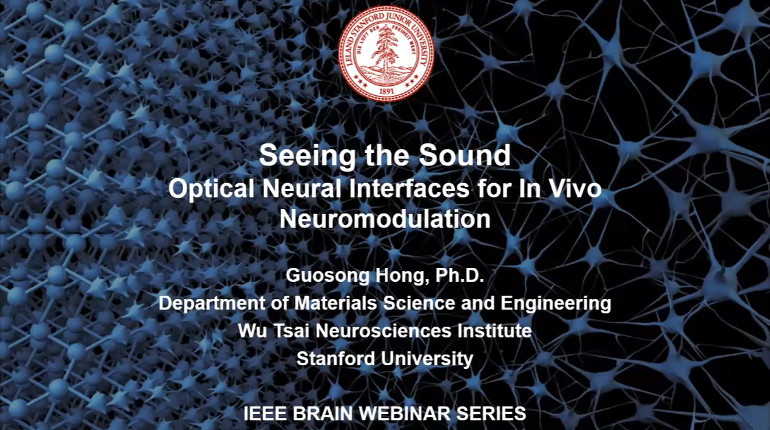
This video program is a part of the Premium package:
IEEE Brain: Seeing the Sound: Optical Neural Interfaces for In Vivo Neuromodulation
- IEEE MemberUS $10.00
- Society MemberUS $0.00
- IEEE Student MemberUS $10.00
- Non-IEEE MemberUS $20.00
IEEE Brain: Seeing the Sound: Optical Neural Interfaces for In Vivo Neuromodulation
Optogenetics has transformed experimental neuroscience by manipulating the activity of specific cell types with light, enabling in vivo neuromodulation with millisecond temporal resolution. Visible light with wavelengths between 430 nm and 640 nm is used for optogenetics, limiting penetration depth in vivo and resulting in an invasive fiber-tethered interface that damages the endogenous neural tissue and constrains the animal’s free behavior. In this talk, Dr. Guosong Hong will present two recent methods to address this challenge: "sono-optogenetics" and "macromolecular infrared nanotransducers for deep-brain stimulation (MINDS)". In the first method, we demonstrate that mechanoluminescent nanoparticles can act as circulation-delivered nanotransducers to convert sound into light for noninvasive optogenetic neuromodulation in live mice. In the second method, we demonstrate 1064-nm near-infrared-II light can penetrate the brain to reach 5-mm depths for modulating neural activity in tether-free, freely behaving animals. Dr. Hong will present an outlook on how new optical neural interfaces may advance neuroscience research by reducing the invasiveness and mechanical restraints in live animals and even humans.
Optogenetics has transformed experimental neuroscience by manipulating the activity of specific cell types with light, enabling in vivo neuromodulation with millisecond temporal resolution. Visible light with wavelengths between 430 nm and 640 nm is used for optogenetics, limiting penetration depth in vivo and resulting in an invasive fiber-tethered interface that damages the endogenous neural tissue and constrains the animal’s free behavior. In this talk, Dr. Guosong Hong will present two recent methods to address this challenge: "sono-optogenetics" and "macromolecular infrared nanotransducers for deep-brain stimulation (MINDS)". In the first method, we demonstrate that mechanoluminescent nanoparticles can act as circulation-delivered nanotransducers to convert sound into light for noninvasive optogenetic neuromodulation in live mice. In the second method, we demonstrate 1064-nm near-infrared-II light can penetrate the brain to reach 5-mm depths for modulating neural activity in tether-free, freely behaving animals. Dr. Hong will present an outlook on how new optical neural interfaces may advance neuroscience research by reducing the invasiveness and mechanical restraints in live animals and even humans.
 Cart
Cart Create Account
Create Account Sign In
Sign In





